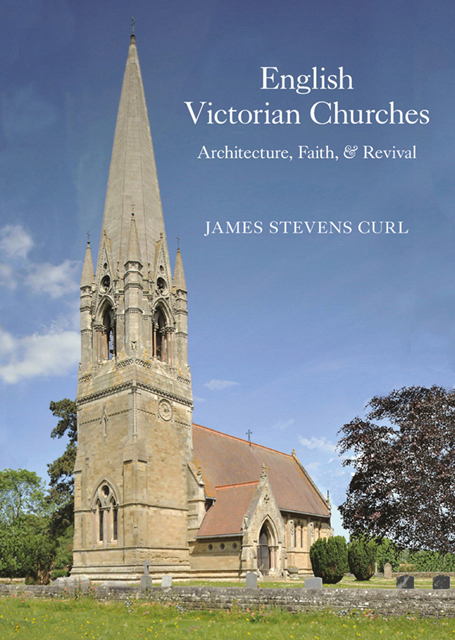Book contents
- Frontmatter
- Dedication
- Contents
- Foreword by Barry Orford
- Preface and Acknowledgements
- Note on Illustrations
- 1 An Introduction to Denominations and Victorian Churches
- 2 Architecture, Antiquarianism, and Styles
- 3 The Religious Atmosphere in the 1830s and 1840s
- 4 Recusants, Goths, Converts, Ultramontanes, and Controversies
- 5 The Anglican Revival
- 6 The Search for an Ideal
- 7 Church Architecture of the 1850s, 1860s, and Early 1870s
- 8 The Late Victorian Anglican Church in Several Manifestations
- 9 Non-Anglican Buildings for Religious Observance
- 10 Epilogue
- Select Glossary
- Select Bibliography
- Index
- Frontmatter
- Dedication
- Contents
- Foreword by Barry Orford
- Preface and Acknowledgements
- Note on Illustrations
- 1 An Introduction to Denominations and Victorian Churches
- 2 Architecture, Antiquarianism, and Styles
- 3 The Religious Atmosphere in the 1830s and 1840s
- 4 Recusants, Goths, Converts, Ultramontanes, and Controversies
- 5 The Anglican Revival
- 6 The Search for an Ideal
- 7 Church Architecture of the 1850s, 1860s, and Early 1870s
- 8 The Late Victorian Anglican Church in Several Manifestations
- 9 Non-Anglican Buildings for Religious Observance
- 10 Epilogue
- Select Glossary
- Select Bibliography
- Index
Summary
We have not originated a new style, but are called upon to re-awaken one which has for centuries lain dormant; and it is absurd to argue that, because those who originated it did not scruple, during its progress, at destroying specimens of the earlier varieties, to make way for what they thought better, we are equally free to destroy their works to make way for our own.
George Gilbert Scott (1811–78): A Plea for the Faithful Restoration of our Ancient Churches(London: John Henry Parker, 1850), 25–6, 33.Church Restoration
No study of Victorian churches can afford to omit a mention of the importance of church restoration, for such work is likely to have taken as much of the energies of the architects and builders of the period as did new structures. Some of the biggest architectural names involved in designing new churches were also those associated with ancient ecclesiastical fabric, and foremost among them was that of ‘Great’ Scott.
At the beginning of the Victorian era, many churches were in a poor state of repair, and to our eyes often would have looked distressingly bare, unkempt, and plain. Fittings and furnishings were very frequently of dates much later than the end of the Middle Ages: they included tall panelled Georgian ‘box pews’, ‘three-decker’ pulpits, Jacobean or Caroline Communion rails, and a plethora of funerary monuments, not all of which were without historical or æsthetic merit by any means, and indeed over-zealous Victorian clear-outs unquestionably led to losses that should not have occurred. Not unusually, mediæval features, such as piscinæ, sedilia, and altars, were hidden behind plaster, buried, or had been destroyed. Mediæval stained-glass windows were rare, and skills in restoring or recreating them had to be learned from scratch. Those Victorian architects, reared on Ecclesiology, and cognisant with mediæval architecture, felt duty-bound not only to preserve mediæval churches, but to restore them, with all their furnishings and fittings. Box pews, Commandment boards, pulpits, and much else were ruthlessly swept out, and new work in the Gothic style put in. Some architects sought a feeling of completeness, of homogeneity, in their restoration work, so a church and its fittings, begun, say, in the Norman period, and added to over the next 700 years, might be reborn in the Second Pointed style, so much genuine Romanesque, Pointed, Perpendicular, Elizabethan, Jacobean, Caroline, Carolean, Restoration, and Georgian work was obliterated in the process.
- Type
- Chapter
- Information
- English Victorian ChurchesArchitecture, Faith, and Revival, pp. 181 - 186Publisher: Boydell & BrewerPrint publication year: 2022

